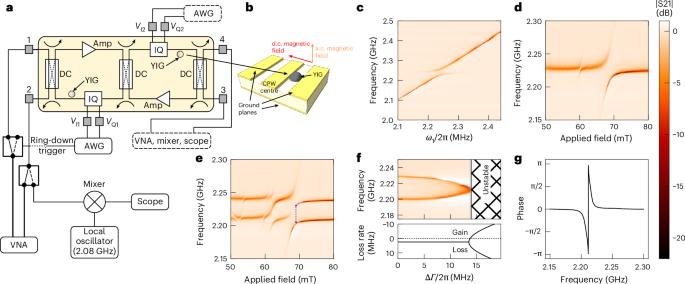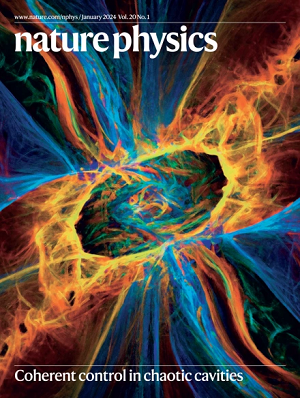Coherent control of magnon–polaritons using an exceptional point
IF 18.4
1区 物理与天体物理
Q1 PHYSICS, MULTIDISCIPLINARY
引用次数: 0
Abstract
In a non-Hermitian system, the amplitude of resonant oscillations can either grow or decay in time, corresponding to a mode with either gain or loss. When two coupled modes have a specific gain–loss imbalance, an exceptional point emerges at which both eigenfrequencies and eigenmodes of the system coalesce. Exceptional points have qualitative effects on the dynamics of systems due to their topological properties, and have been used to control systems including optical microcavities, the lasing of a parity–time-symmetric waveguide and terahertz pulse generation. A challenging open problem is the fully deterministic and direct manipulation of the systems’ loss and gain on timescales relevant to the coherent control of excitations. Here we demonstrate the rapid manipulation of the complex frequency of magnon–polaritons on durations much shorter than their decay rate, allowing us to exploit non-Hermitian physics for coherent control. By dynamically encircling an exceptional point, we demonstrate population transfer between coupled magnon–polariton modes. We then drive the system directly through an exceptional point, and demonstrate that this allows the coupled system to be prepared in an equal superposition of eigenmodes. These findings establish a highly controllable hybrid platform for exploring the rich dynamical properties of non-Hermitian systems. Deterministic control of the gain–loss balance in non-Hermitian systems remains challenging. A magnonic hybrid platform is now shown to enable this and, hence, coherently control excitations by leveraging an exceptional point.

利用异常点对磁非极化子进行相干控制
在非厄米系统中,谐振振荡的振幅随时间增长或衰减,对应于具有增益或损耗的模态。当两个耦合模具有特定的增益-损失不平衡时,系统的本征频率和本征模会在一个特殊点上合并。异常点由于其拓扑性质对系统的动力学具有定性影响,并且已被用于控制系统,包括光学微腔,奇偶时间对称波导的激光和太赫兹脉冲的产生。一个具有挑战性的开放问题是在与激励的相干控制相关的时间尺度上对系统损失和增益的完全确定性和直接操纵。在这里,我们展示了对磁非极化子复频率的快速操纵,其持续时间远短于其衰变速率,使我们能够利用非厄米物理进行相干控制。通过动态环绕一个异常点,我们证明了耦合磁非极化模式之间的人口转移。然后,我们直接通过一个异常点驱动系统,并证明这允许在本征模的相等叠加中制备耦合系统。这些发现为探索非厄米系统的丰富动力学性质建立了一个高度可控的混合平台。非厄米系统中损益平衡的确定性控制仍然具有挑战性。现在展示了一个磁振子混合平台来实现这一点,因此,通过利用一个特殊点来相干地控制激励。
本文章由计算机程序翻译,如有差异,请以英文原文为准。
求助全文
约1分钟内获得全文
求助全文
来源期刊

Nature Physics
物理-物理:综合
CiteScore
30.40
自引率
2.00%
发文量
349
审稿时长
4-8 weeks
期刊介绍:
Nature Physics is dedicated to publishing top-tier original research in physics with a fair and rigorous review process. It provides high visibility and access to a broad readership, maintaining high standards in copy editing and production, ensuring rapid publication, and maintaining independence from academic societies and other vested interests.
The journal presents two main research paper formats: Letters and Articles. Alongside primary research, Nature Physics serves as a central source for valuable information within the physics community through Review Articles, News & Views, Research Highlights covering crucial developments across the physics literature, Commentaries, Book Reviews, and Correspondence.
 求助内容:
求助内容: 应助结果提醒方式:
应助结果提醒方式:


